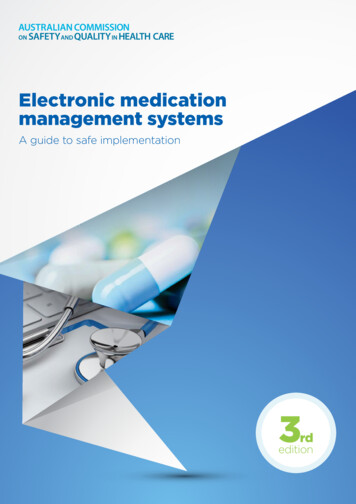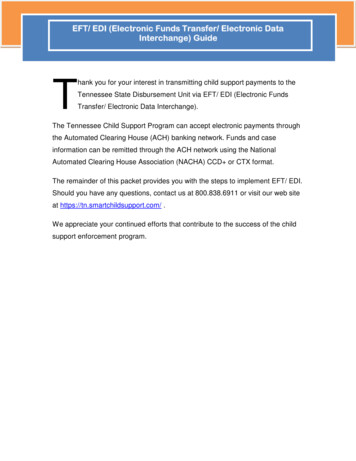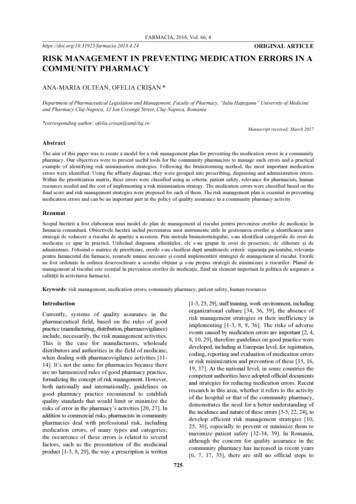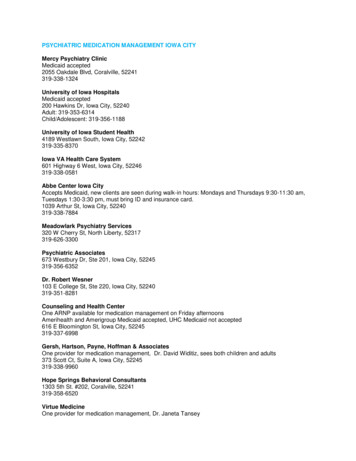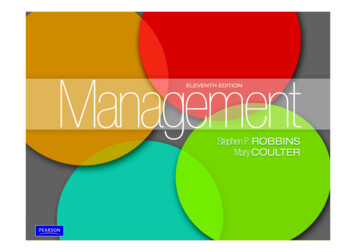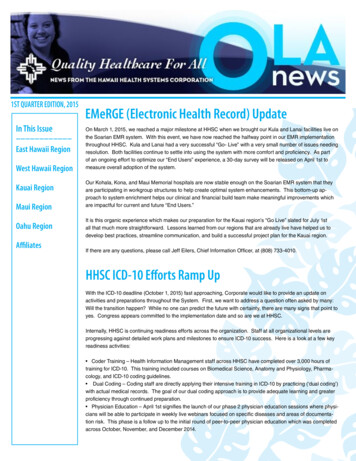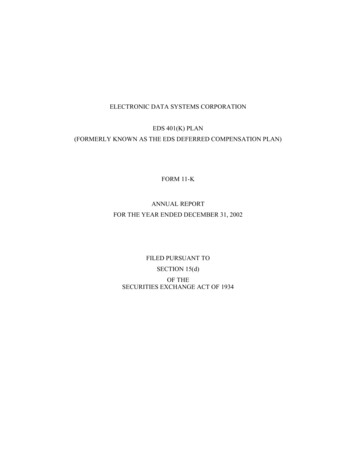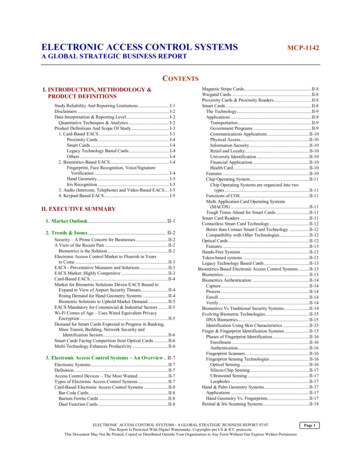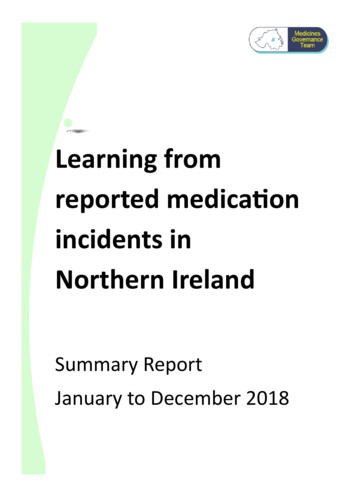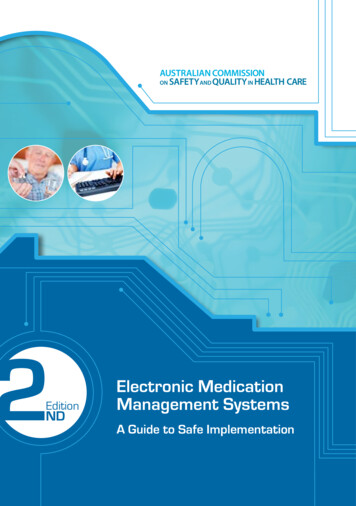
Transcription
2EditionNDElectronic MedicationManagement SystemsA Guide to Safe Implementation
Electronic MedicationManagement SystemsA Guide to Safe Implementation2nd Edition
Electronic Medication Management Systems — A Guide to Safe Implementation,2nd edition, 2012.ISBN Print: 978-1-021983-19-1ISBN Online: 978-1-921983-20-7 Commonwealth of Australia 2012This work is copyright. It may be reproduced in whole or in part for study or trainingpurposes subject to the inclusion of an acknowledgement of the source. Requests andinquiries concerning reproduction and rights for purposes other than those indicatedabove requires the written permission of the Australian Commission on Safety andQuality in Health Care, GPO Box 5480 Sydney NSW 2001 ormail@safetyandquality.gov.au.Suggested citation:Australian Commission on Safety and Quality in Health Care. Electronic MedicationManagement Systems — A Guide to Safe Implementation, 2nd edition, ACSQHC,Sydney, 2012.Acknowledgements:The Australian Commission on Safety and Quality in Health Care (ACSQHC) wishesto acknowledge the contribution of participating clinicians and organisations in thedevelopment and review of this guide. The first edition of this guide was developed byKPMG in conjunction with Trilogy Information Solutions. The principal author of thesecond edition was Steve Saunders of Trilogy Information Solutions and the principalreviewer was Katrina Richardson of St Vincent’s Hospital. To provide feedback on thisguide, please contact ACSQHC.This document can be downloaded from the ACSQHC web site:www.safetyandquality.gov.auACSQHC can be contacted at:Australian Commission on Safety and Quality in Health CareGPO Box 5480Sydney NSW 2001Tel:02 9263 3633Fax:02 9263 3613Email:mail@safetyandquality.gov.auIf calling from overseas:Tel: 61 2 9263 3633Fax: 61 2 9263 3613Edited and produced by Biotext, Canberra
ContentsPreface. ixAcronyms and abbreviations. xi1Overview. .32How to use this guide. 52.1Clinicians.62.2Private hospitals.62.3Australian Government–funded programs.62.4Members of EMM governance.62.5Information and communications technology personnel.7Section A EMM system context and requirements. 93The case for change.114Essential elements for EMM implementation.135The medication management continuum.155.1The inpatient medication management process. 156The EMM strategic and business contexts.216.1The strategic context. 216.2The business context. 237EMM and the Pharmaceutical Benefits Scheme.257.1PBS prescriptions in public hospital outpatient settings. 267.2PBS prescriptions for public hospital discharges. 267.3PBS access in private hospitals. 288EMM and the National Medication Work Program.298.1Electronic transfer of prescriptions. 298.2The Personally Controlled Electronic Health Records program. 308.3The Australian Medicines Terminology. 308.4Implications for EMM systems. 319Functional and technical specifications for EMM systems.339.1Prioritising EMM functional and technical components. 339.1.19.1.29.1.39.2Core features. 34Desirable features. 34Aspirational features. 34Functional components. 35Functional component 1.0: General. 38 iii
Functional component 2.0: Medication orders. 45Functional component 3.0: Clinical decision support. 50Functional component 4.0: Pharmacy review. 55Functional component 5.0: Medication dispensing. 57Functional component 6.0: Medication administration. 579.3Technical components — software. 63Technical component 8.0: Standards and terminology. 64Technical component 9.0: e-health interoperability. 67Technical component 10.0: Support system integration. 699.4Technical components — hardware. 70Technical component 11.0: Infrastructure.71Technical component 12.0: Devices. 729.5Technical components — business continuity management. 75Technical component 13.0: Business continuity. 76Section B EMM organisational considerations.7910Principal stakeholders and key users.8110.1 Principal stakeholders and decision makers. 8110.1.1 Chief executive officer.8110.1.2 Director of medical services / medical superintendent / medical .champions. 8210.1.3 Director of pharmacy. 8310.1.4 Director of nursing and midwifery. 8410.1.5 Chief information officer. 8510.1.6 Drug and therapeutics committee. 8610.2Key users. 8610.2.110.2.210.2.310.2.411Governance.9111.1 Project sponsor. 9311.2 Project board. 9311.3 Project manager. 9311.4 Project team. 9411.5 Reference group and specialty subgroups. 9511.6 Project management. 9611.6.111.6.211.6.311.6.411.6.512ivPrescribers. 87Pharmacists. 87Nurses and midwives. 88Shared user responsibilities. 89Role of the project management office. 96Project management methodology. 97EMM project schedule. 98Risks and issues management. 98Project reporting. 100Change management.10112.1 Stakeholder assessment. 10212.2 Targeted engagement strategies. 10212.3 Change readiness assessments.10412.4 Addressing stakeholder concerns.10512.5 Identifying champions and change agents.105Electronic Medication Management Systems — A Guide to Safe Implementation
13Sustainability of the EMM system.10713.1 Ongoing resourcing. 10713.2 Ongoing evaluation of the EMM system. 10713.3 Continuous adaptation.10813.4 Ongoing database configuration and maintenance.10913.5 EMM software upgrades.11013.6 Consolidating education and training.11013.6.1 Periodic refresher training.11013.6.2 Targeted training for specific issues and users.11013.713.8Ongoing vendor support.111Benefits measurement.111Section C The EMM implementation project.11314The EMM system implementation process.11515Stage 1 — Project initiation.11715.1 Developing the EMM business case. 11715.1.1 First-stage business case. 11915.1.2 Second-stage business case.12015.215.3Obtaining funding approval.121Procurement, product evaluation and ject procurement plan. 121Procurement considerations.122Tender documentation.124Tender evaluation.125Product evaluation and selection.127Contract management.13315.4.1 Contract management plan.13415.4.2 Contract management meetings.13415.4.3 Monitoring vendor performance.13416Stage 2 — Implementation planning.13516.1 The implementation planning study.13516.2 Implementation scope.13716.3 Business process mapping and redesign.13816.3.1 Current-state process maps.13816.3.2 Future-state process maps.13916.416.516.616.7Policy development.140Avoiding the pitfalls.141Implementation sequence planning.142Evaluation .816.9The evaluation framework.145Expected outcomes.146Baseline indicators.146Evaluation activities.148Checkpoint and milestone reviews.149Post-implementation review planning.149Benefits management planning.150Education and training.152 v
16.9.116.9.216.9.316.9.416.9.5Education planning and materials.152Training and materials.153Role-based tailored training courses.154Dedicated training time and space.155Timing of the training.15516.10 Project communications.15616.10.1 The communications plan.15616.10.2 Communication tools.15716.11 Quality management.15717Stage 3 — EMM system build and configuration.15917.1 Acquiring technical infrastructure and planning business continuitymanagement.15917.2 Software development.
Box 18.1 EMM system implementation checklist. 167. ix Preface Medication errors remain the second most common type of medical incident reported in hospitals and, of all medication errors, omission or
